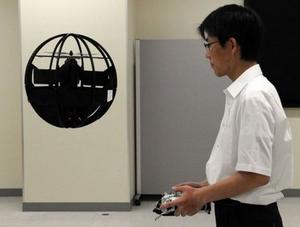SurveillanceBeachball-like observation UAV developed
A beach ball-size drone can fly down narrow alleys, hover on the spot, take off vertically, bounce along the ground like a soccer ball — all the time transmitting live images from a video camera; it can travel above traffic or spy on a target through a window — and can also be used in search and rescue in disaster zones, where it could fly through buildings and even up and down stairways

Fumiyuki Sato with his beachball UAV // Source: xatakaciencia.com
A Japanese researcher working for Japan’s Ministry of Defense has developed a spherical observation UAV that can fly down narrow alleys, hover on the spot, take off vertically, bounce along the ground like a soccer ball – all the time transmitting live images from a video camera.
The drone – or Spherical Air Vehicle (SAF) — is the size of a beach ball, and it is controlled by an operator with a remote control. It is powered by a propeller protected by a spherical shield with large openings for airflow, allowing it to hit a wall or a tumble to the ground without damaging the propeller. Tech.blorge reports that the device’s designer is continuing to work to improve it. The designer says that in the future the SAF could be used as a formidable pursuit vehicle that can travel above traffic or spy on a target through a window.
Its inventor says it could also help in such as search and rescue in disaster zones, where it could fly through buildings and even up and down stairways.
The developer, Fumiyuki Sato, a research engineer at the Technical Research and Development Institute Ministry of Defense, said that “This is the world’s first spherical air vehicle.”
The latest SAF model weighs 350 grams (12.3 ounces) and has a diameter of 42 centimeters (16.8 inches); it can reach a speed of 37 miles per hour.
Sato said all its components can be found in shops in Tokyo’s electronic stores — or on the Internet. The coast of the parts, including the motor, come to 110,000 yen ($1,400) for the latest model.
Sato says there are still obstacles to be overcome before the SAF can be out to practical use – among them coping with turbulence and harsh weather conditions. Also, the current model requires the operator to keep the device in his vision in order to control it.
A more advanced model will solve these problems, Sato said. It could then hover above a motorcade for security, or, if in pursuit of a fleeing target, “it could go below an electric cable, fly above the next one, and then turn a street corner.”
